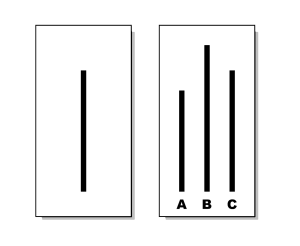Solomon Asch Experiment
In 1951, Solomon Asch devised an experiment to study the tendency for humans to conform. In his experiment, eight to ten people were seated around a table and asked to determine which bar on the right card as seen below, most closely matches the bar on the left card as seen below.
The bars on the right were varied, but it was always obvious which one most closely resembled the bar on the left card. In the experiment, all but one person was planted by Asch, with this remaining person being the subject. The subject was told that this experiment was to test visual judgements. The confederates of the experiment were told to give some correct answers, and then incorrect answers near the last few cards on certain ‘staged’ trials. The results were that 37 of 50 subjects conformed themselves to ‘obviously erroneous’ answers, with the mean person conforming on 4 of the ‘staged’ trials. Asch was troubled by these results, stating: “The tendency to conformity in our society is so strong that reasonably intelligent and well-meaning young people are willing to call white black.”
Read more about the experiment here: http://www.age-of-the-sage.org/psychology/social/asch_conformity.html
This experiment is extremely relevant to our study of crowds. It shows that a person will ignore private information under the assumption that the crowd is correct, even if the crowd completely contradicts the private information.

